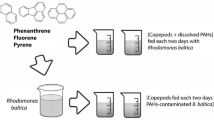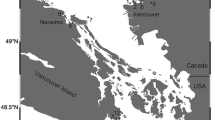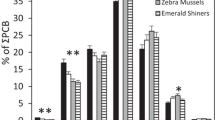Abstract
Experiments were conducted to study the distribution of three selectedpolychlorinated biphenyl (PCB) congeners within the microbial food web attwo different nutrient levels; control and nutrient enriched. The objectivewas to quantify the uptake of PCBs through grazing by protozoa. The14C-PCBs tested were 4-chlorobiphenyl (IUPAC # 3),2,2′,5,5′-tetrachlorobiphenyl (IUPAC # 52), and2,2′,4,4′,5,5′-hexachlorobiphenyl (IUPAC # 153). EachPCB was incubated in triplicate seawater samples at 20 idref;Cover one week. Daily, samples were separated into four fractions; <0.2µm (dissolved), 0.2-2 µm (bacteria), 2-10 µm(flagellate), and > 10 µm (microplankton; phytoplankton andprotozoa) by selective filtration. Of the PCB fraction that initiallyadsorbed to particles, 60–100% was associated to the bacterialfraction and 0–5% to the microplankton fraction. The totaluptake was highest in the nutrient enriched samples, but when normalized tothe carbon biomass the concentration was lower or equal to the control inall particle fractions. The recovery of the PCBs in the particulatefractions depended on the degree of chlorination, as the highest values wereobserved for the 2,2′,4,4′,5,5′-hexachlorobiphenyl and thelowest for the 4-chlorobiphenyl. The concentrations in the bacterial andflagellate fractions decreased over the first 48–96 hours whilst theconcentration increased in the highest trophic level (>10 µmfraction). Approximately 75% of the increase in concentration of the2,2′,4,4′,5,5′-hexachlorobiphenyl in the > 10 µmfraction was estimated to be the result of bacterivory. Our results indicatethe microbial food web can contribute to a rapid uptake of higherchlorinated PCBs, particularly in oligotrophic ecosystems where thebacterial biomass dominates.
Similar content being viewed by others
References
Abramowicz, D. A., 1990. Aerobic and anaerobic biodegradation of PCBs: A review. Biotechnology 10: 241-251.
Andersen, P. & T. Fenchel, 1985. Bacterivory by microheterotrophic flagellates in seawater samples. Limnol. Oceanogr. 30: 198-202.
Autenrieth, R. L. & J. V. DePinto, 1991. Desorption of chlorinated hydrocarbons from phytoplankton. Envir. Sci. Technol. 10: 857- 872.
Axelman, J., D. Broman & C. Näf, 1997. Field measurements of PCB partitioning between water and plankton organisms: influence of growth, particle size, and solute-solvent interactions. Envir. Sci. Technol. 31: 665-669.
Cho, B. C. & F. Azam, 1990. Biochemical significance of bacterial biomass in the ocean's euphotic zone. Mar. Ecol. Prog. Ser. 63: 253-259.
Cole, J. J., S. Findlay & M. L. Pace, 1988. Bacterial production in a fresh and saltwater ecosystem: a cross-system overview. Mar. Ecol. Prog. Ser. 43: 1-10.
Cole, J. J. & N. F. Caraco, 1993. The pelagic microbial food web of oligotrophic lakes. In Ford, T. E. (ed.), Aquatic Microbiology. An Ecological Approach-1993. Blackwell Scientific Publications. Boston: 101-111.
Ducklow, H. W. & C. A. Carlson, 1992. Oceanic bacterial production. Adv. Microbiol. Ecol. 12: 113-181.
Edler, L., 1979. Recommendations on methods for marine biological studies in the Baltic Sea. The Baltic Marine Biologist (BMB) Publ. No 5, Malmö.
Fessenden, L. & T. J. Cowles, 1994. Copepod predation on phagotrophic ciliates in Oregon coastal waters. Mar. Ecol. Prog. Ser. 107: 103-111.
Fuhrman, J. A. & F. Azam, 1982. Thymidine incorporation as a measure of heterotrophic bacterioplankton production in marine surface waters: evaluation and field results. Mar. Biol. 66: 109- 120.
Grasshoff, K., M. Ehrhardt & K. Kremling, 1983. Methods of Seawater Analysis. 2nd edn. Verlag Chemie, Weinheim.
Hawker, D. W. & D. W. Connell, 1988. Octanol-water partition coefficients of polychlorinated biphenyl congeners. Envir. Sci. Technol. 22: 382-387.
Hobbie, J. E., R. J. Daley & S. Jasper, 1977. Use of nucleopore filters for counting bacteria by fluorescence microscopy. Appl. envir. Microbiol. 33: 1225-1228.
Iriberri, J., B. Ayo, E. Santamaria, I. Barcina & L. Egea, 1995. Influence of bacterial density and water temperature on the grazing activity of two freshwater ciliates. Freshwat. Biol. 33: 223-231.
Iwata, H., S. Tanabe, N. Sakai & R. Tatsukawa, 1993. Distribution of persistent organochlorines in the oceanic air and surface seawater and the role of ocean on their global transport and fate. Envir. Sci. Technol. 27: 1080-1098.
Johnson, M. G., J. R. Kelso & S. E. George, 1988. Loading of organochlorine contaminants and trace elements to two Ontario lake systems and their concentrations in fish. Can. J. Fish. aquat. Sci. 44: 3-13.
Jumars, P. A., D. L. Penry, J. A. Baross, M. J. Perry & B. W. Frost, 1989. Closing the microbial loop: dissolved carbon pathway to heterotrophic bacteria from incomplete ingestion, digestion and absorption in animals. Deep-Sea Res. 36: 483-495.
Mackay, D., W. Y. Shiu & K. C. Ma, 1992. Illustrated handbook of physical chemical properties and environmental fate for organic chemicals. Vol 1. Lewis publisher, London.
McKim, J., P. Schmieder & G. Veith, 1985. Absorption dynamics of organic chemical transport across trout gills as related to octanol-water partition coefficient. Toxicol. Appl. Pharmacol. 77: 1-10.
Millard, E. S., E. Halfon, C. K. Minns & C. C. Charlton, 1993. Effect of primary productivity and vertical mixing on PCB dynamics in planktonic model ecosystems. Envir. Toxicol. Chem. 12: 931- 946.
Nielsen, T. G., B. Løkkegaard, K. Richardson, F. B. Pedersen & L. Hansen, 1993. Structure of plankton communities in the Dogger Bank area (North Sea) during a stratified situation. Mar. Ecol. Prog. Ser. 95: 115-131.
Olsson, M., B. Karlsson & E. Ahnland, 1994. Diseases and environmental contaminants in seals from the Baltic and the Swedish west coast. Sci. Total. Envir. 154: 217-227.
Peters, F., 1994. Prediction of planktonic protistan grazing rates. Limnol. Oceanogr. 39: 195-206.
Richter, G. & R. H. Peters, 1993. Determination of the short-term dynamics of PCB uptake by phytoplankton. Envir. Toxicol. Chem. 12: 207-218.
Sanders, R. W. & S. A. Wickham, 1993. Planktonic protozoa and metazoa: predation, food quality and population control. Mar. Microbiol. Food Webs 7: 197-223.
Schwarzenbach, R. P., P. M. Gschwend & D. M. Imboden, 1993. Environmental organic chemistry. John Wiley & Sons, Inc., New York: 255-341.
Sherr, E. B., F. Rassoulzadegan & B. F. Sherr, 1989. Bacterivory by pelagic choreotrichous ciliates in coastal waters of the N.W. Mediterranean Sea Mar. Ecol. Prog. Ser. 55: 235-240.
Simon, M. & F. Azam, 1989. Protein content and protein synthesis rates of planktonic marine bacteria. Mar. Ecol. Prog. Ser. 51: 201-213.
Stoecker, D. K. & J. Mc. D. Capuzzo, 1990. Predation on Protozoa: its importance to zooplankton. J. Plankton Res. 12: 891-908.
Stange, K. & D. L. Swackhamer, 1994. Factors affecting phytoplankton species-specific differences in accumulation of 40 polychlorinated biphenyls (PCBs). Envir. Toxicol. Chem. 13: 1849-1860.
Strathmann, R. R., 1967. Estimating the organic carbon content of phytoplankton from cell volume or plasma volume. Limnol. Oceanogr. 12: 411-418.
Swackhamer, D. L. & R. S. Skoglund, 1993. Bioaccumulation of PCBs by algae: kinetics versus equilibrium. Envir. Toxicol. Chem. 12: 831-838.
Tanabe, S., H. Iwata & R. Tatsukawa, 1994. Global contamination by persistent organochlorines and their ecotoxicological impact on marine mammals. Sci. Total Envir. 154: 163-177.
Taylor, W. D., J. H. Carey, D. R. S. Lean & D. J. McQueen, 1991. Organochlorine concentrations in the plankton of lakes in Southern Ontario and their relationship ot plankton biomass. Can. J. Fish. aquat. Sci. 48: 1960-1966.
Thomann, R. V., 1989. Bioaccumulation model of organic chemical distribution in aquatic food chains. Envir. Sci. Technol. 23: 699- 707.
Verity, P. G., C. Y. Robertson, C. R. Tonzo, M. G. Andrews, J. R. Nelson & M. E. Sieracki, 1992. Relationships between cell volume and the carbon and nitrogen content of marine photosynthetic nanoplankton. Limnol. Oceanogr. 37: 1434-1446.
Williams, P. J. leB., 1984. Bacterial production in the marine food chain: the emperor's new suite of clothes? In Farsham, M. J. R. (ed.), Flows of Energy and Materials in Marine Ecosystems. Plenum Publ. Corp., London: 271-299.
Author information
Authors and Affiliations
Rights and permissions
About this article
Cite this article
Wallberg, P., Bergqvist, PA. & Andersson, A. Potential importance of protozoan grazing on the accumulation of polychlorinated biphenyls (PCBs) in the pelagic food web. Hydrobiologia 357, 53–62 (1997). https://doi.org/10.1023/A:1003122500557
Issue Date:
DOI: https://doi.org/10.1023/A:1003122500557




